Weapons from time immemorial. Shields and swords of Rome
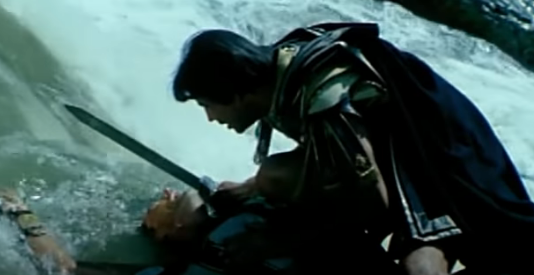
Frame from the movie "Ducks" (1966). The North has finally slaughtered the scoundrel Fusk... The profile of the gladius here is exactly what it should be, but for some reason all the other Roman swords in this film are shown too wide. It is not clear why?
and the sword of thy glory?
Deuteronomy 33:29
... And he took the sword from his right thigh ...
Judges of Israel 3:21
stories about weapons. This article appeared in a somewhat unusual way. Just some time ago, a dispute arose in VO regarding Roman “plywood” shields and swords, the predecessors of the swords of European knights. There were requests to write about this, if only because many new readers have appeared on our site, who have no materials from 2015, 2016, 2017. just didn't read it.
And now I found this material in the archive, just in the subject. I checked it for novelty - much higher than 80%, which means that it did not shine anywhere on the Web before. And the photos are good, visual - just a whole gallery. Well, if so, then ... you are welcome to read the text and look at the photos.
So ... Weapons of the transitional period from the Bronze Age to the Iron Age.
There is evidence that the tribes living in the Danube basin (the territory of modern Austria and Hungary) were the first in Europe to discover the possibility of using iron. The culture that developed in this region was called Hallstatt - after the name of the place where its first archaeological sites were discovered, but historians are not able to say for sure who founded it and who these “people from Hallstatt” were. There is an assumption that they were mercenaries from Urartu and Assyria, and it was from there that they brought their knowledge.
Be that as it may, their swords (and scabbards for these swords) are very similar to Assyrian ones! Moreover, in their form, the swords of the “Hallstatt people” repeated in many respects the early swords of the Bronze Age, but were intended for chopping blows, which means that they should have been used by warriors who fought on war chariots. That is why they were of great length, and the points of their blades were clearly not intended for an injection. They also lacked a crosshair; this suggests that they were not designed for hitting the shield with a handle, but only for a chopping blow on an infantryman from above, that is, from a horse. In fact, these are the real ancestors of the later knightly swords!
However, not everything here is as simple as it seems, because the types of swords in the vast territory of Europe, including in areas influenced by the Hallstatt culture, were constantly changing. True, their main types, which appeared between 950 and 450 BC. e., only three: a long bronze sword for chopping blows, a heavy iron sword that retained the shape of the bronze original, and finally a short iron sword, shaped like a reed leaf and somewhat expanding towards the tip.
On the other hand, the Hallstatt swords themselves practically did not change: they had a very characteristic handle, the pommel of which resembled ... a Mexican sombrero!
The length of one of these surviving swords from pommel to tip is 108 centimeters, that is, it most likely belonged to a horseman who needed to chop from a chariot, and not to an infantryman, for whom it is clearly large. The Hallstatts also had shorter swords, with a pommel in the form of antennas bent in different directions; one of them was found in the Thames, right in the middle of London!
However, earlier swords with "antenna" pommel, made entirely of bronze, are also known. So this, apparently, is just the case when gunsmiths simply took it and replaced one blade material with another, and left everything else unchanged.
Excavations in the burials of the Hallstatt warriors do not give the slightest hint of how they carried their long swords. Here you should pay attention to one interesting detail at the end of their scabbard, which in shape resembles “wings” spread apart. There are no signs of wear and friction on the ground on the "wings" of specimens found in the burials, which means that they did not touch the ground!
Interestingly, the Assyrians also had similar bindings at the ends of the scabbards, as evidenced by the figures from the bas-reliefs from the Assyrian palaces. At the same time, it is significant that the swords of the Assyrians hang on their belts in such a way that their handles are right at the chest, and why this is so is understandable. After all, if a warrior fights while standing on a chariot, then the sheath simply cannot hang between his legs, because in this case he can catch on to them and fall! Well, the fetters are needed as an emphasis at the moment when their long sword was snatched from their long scabbard!
As for the shape of the swords, it was mainly determined by the tactics of the battle. It is known that the Greek warriors fought in phalanx, hiding behind large painted shields. The phalanx consisted of 1-000 people along the front and eight rows in depth, and its main weapons were not swords, but spears. Swords were used to a limited extent, firstly, if a warrior's spear broke, and secondly, in order to finish off an enemy who was defeated to the ground; images of such episodes are very common on ancient Greek vases.
The swords of the Greeks were 60–75 centimeters long and were intended to stab and chop; moreover, these were not only straight swords, but also curved single-edged mahair swords that originated from Spain. As the coherence of the actions of the phalanx warriors developed, the length of the swords began to decrease - this was especially noticeable in the army of Sparta - so that by 425-400. BC e. they began to look like small daggers.
The Spartan commander Antalactis was once asked why, they say, Spartan swords are so short, to which he replied:
That is, the training of all warriors as a whole was more important than the individual fighting qualities of each warrior individually.
Thus, the sword was shortened by the Spartans in order to make it more convenient in the crush that arose during the clash of two phalanxes. It is clear that even a warrior deprived of armor, but dexterous and evasive, could win a victory in it. That is why in the XNUMXth century the Spartans completely abandoned armor, with the exception of shields and helmets, and they attacked the enemy on the run! If at the time of the collision the Spartan's spear broke, his short sword made it possible to inflict stabbing blows aimed at the face, hips, and stomach.
Following the Spartans, the Greeks from other policies also began to abandon armor, leaving only helmets and shields for their soldiers! That is, the training of warriors acting together was, in their opinion, much more important than the skill of owning weapons of each separately!
The Celts, a warlike people who settled in Western Europe, at the beginning of the XNUMXth century BC. e. they fought standing on two-horse chariots and throwing darts at the enemies, and when the darts ended, they descended to the ground and converged with the enemy on foot.
However, quite soon four types of warriors appeared among the Celts: infantrymen in heavy armor, whose main weapon was a sword, lightly armed infantrymen - throwers of darts, horsemen and fighters in chariots. According to the descriptions of ancient Roman historians, Celtic warriors in battle usually raised their swords above their heads and brought them down on the enemy from above, as if they were chopping firewood.
There are literally hundreds of Celtic swords, so that scientists were able to study and classify them well. Since a number of such swords were discovered in the Swiss town of La Tène, the culture to which they were characteristic was called La Tène and even four phases were distinguished in it.
La Tene swords were 55–75 centimeters long, looked like a rhombus in cross section, and their hilts were cast from bronze. They were worn not on the left side, but on the right, on an iron or copper chain.
In the time of Caesar, the swords of the Celts began to reach one or more meters in length, and their handles began to be decorated with enamel and even precious stones. But shorter swords also did not go out of use - the Celts fought very skillfully with them. It was not at all easy for the Romans to fight them, and therefore they had no choice but to develop appropriate weapons and tactics for their use!
So, in response to the threat from the Celts, whom the Romans called the Gauls, in Rome they created the most wonderful complex of weapons of all that had ever existed before!
Firstly, the Roman legionnaires were armed with a piercing-chopping sword "gladius hispanicus", which, as its name implies, came from Spain. The two earliest swords of this type were found in Slovenia and date back to around 175 BC. e. They have rather thin, rhombic-section blades 62 and 66 centimeters long, which are indeed somewhat similar to gladiolus sheets; they are really convenient for both chopping and stabbing.
Their second most important weapon was the pilum dart, which was intended primarily to disable the shield of an enemy warrior and, if possible, injure him.
Oh, it was a truly unique weapon, the main feature of which was very long - almost a meter! - a thin metal rod connecting its tip to a handle of approximately the same length. Each legionnaire usually had two of these darts.
They were used in the following way: the legionary put his first two fingers into the belt loop-ementum, located at the center of gravity of the pilum, and, holding his hand palm up, threw it into the enemy's shield. Moreover, the range of such a throw could reach 60 m. The tip pierced into the shield and got stuck in it, a thin rod made of soft iron bent under the weight of the handle, and the shaft dragged along the ground, depriving the enemy warrior of the opportunity to use his shield as a cover.
The second dart flew at the same time at the target, already deprived of protection. After all, the enemy warrior had to throw his damaged shield, and he could not chop off the pilum stuck in it with a sword because of the large length of its metal rod. Judging by the bas-reliefs and artifacts that have come down to us, pilums were often specially weighted with one or two lead balls, fixed at the junction of the tip with the shaft, which increased its weight and ... accordingly - penetrating power!
But perhaps the most impressive invention of the Romans in the field of military affairs (although most historians believe that here, as in the case of the gladius, it was not without borrowing!) Was the shield - the scutum, which all the "heavy" infantrymen of the Roman army had without exception, except that the standard-bearers and senior commanders used round shields (ketra)! Oval and flat at the very beginning of his "career", he subsequently first lost two semicircles above and below and turned into a curved rectangle, similar to a piece cut from a huge pipe, about seventy centimeters wide and more than a meter high!
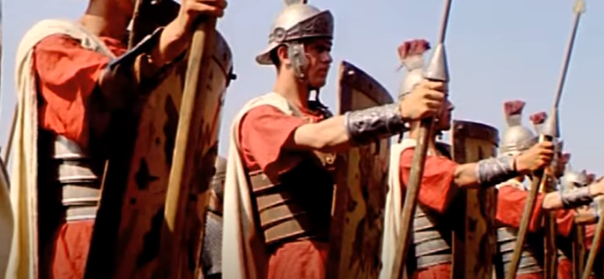
In the movie "Ducks" (1966), the shields of the legionnaires are too small, and instead of a ball, cones are put on the pilums for some reason ...
The shield, if we talk about it in the language of modernity, was plywood. That is, it was assembled and glued from thin wooden plates, after which it was covered with leather and felt, and then with cloth on top, and it was primed and brightly painted, thus turning the shield into an emblem for recognizing a fighter of one or another unit. The handle of the shield was under a special recess made for it, which was covered with a special bulge - an umbon.
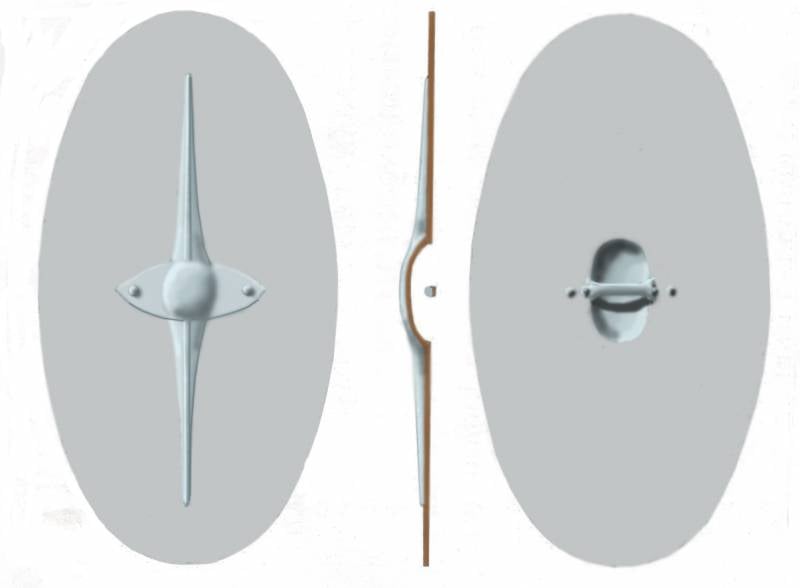
Celtic Shield Fig. A. Shepsa
In early shields it was wooden, while in later ones it was metal. The handle behind him was located horizontally. In addition, the shield had upholstered edges of rolled copper or brass U-shaped profile. Such a shield could weigh under ten kilograms. A real “garden gate”, and nothing more, and with it the legionnaire went into battle, hiding behind it, that is, this very “door”, from head to toe.
It was impossible to somehow maneuver such a shield, and it was not required. Because in battle everything was decided by the tactics and training of the entire legion as a whole. Attacking the enemy, the legionnaires marched on him in orderly rows, carrying shields in front of them, and their success in battle depended primarily on the coordinated actions of the entire legion or cohort.
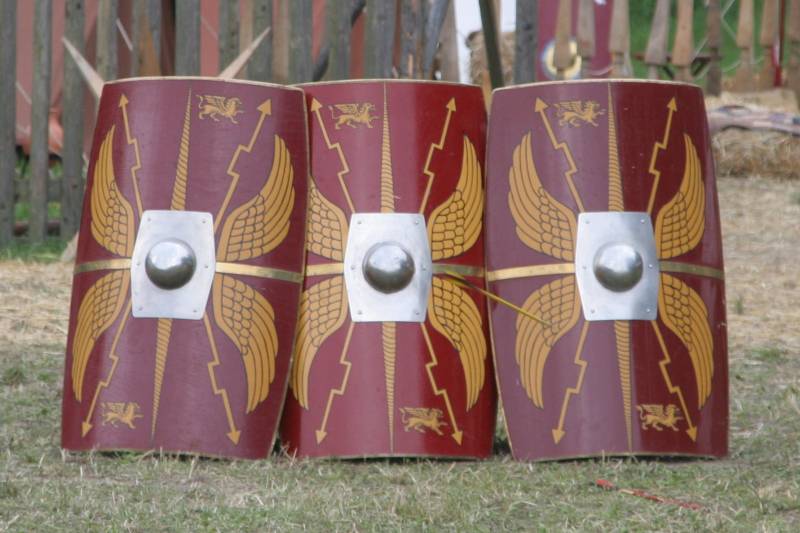
Roman shields. Modern reconstruction
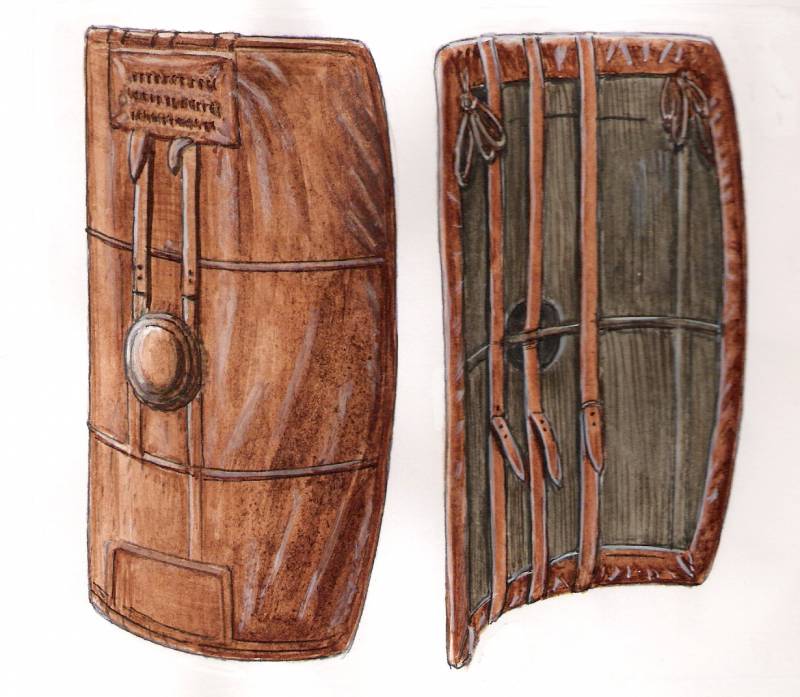
Scutum in a leather carrying case. Rice. A. Sheps
At the signal of the centurions, the legionnaires, coming closer to the enemy, went on the run (before that, they had already launched their pilums towards the enemy!) And brought down on him both the weight of his body and the weight of the shield, and tried to knock him down. If the enemy fell, they simply finished him off with a blow of the sword, piercing the very handle (which is why the gladius had such a pronounced point), and stabbing in this case was, of course, much more convenient than chopping while lying down.
So they, that is, the legionnaires, needed a short sword! And from an enemy with a long chopping sword, for example, a German or a Gaul, they were protected by the metal edge of the shield, which did not allow it to be cut (this also interfered with the location of the rails inside) with one blow.
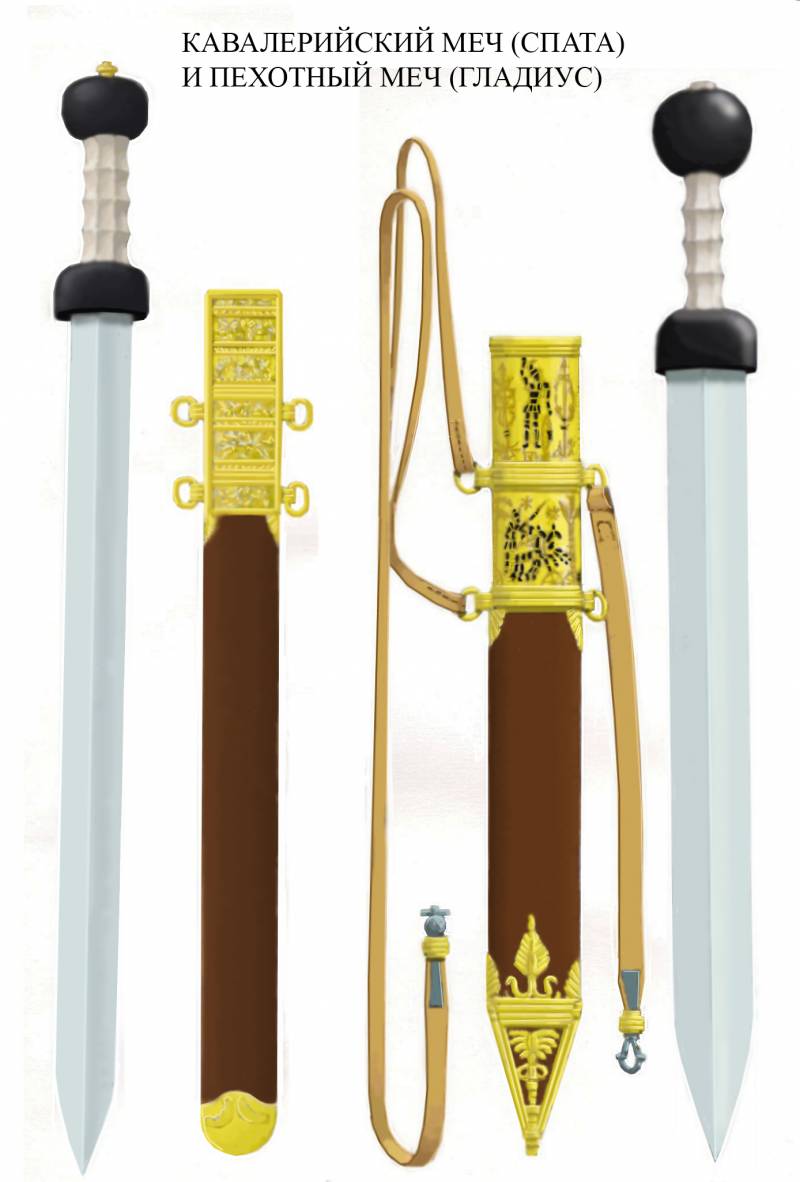
Spatha and gladius. Rice. And Sheps
The rider's sword - spatha - was somewhat longer than the infantryman's gladius, but this is due to the fact that he had to cut the enemy from his horse. And so both swords were identical in design: a diamond-shaped blade, handles made of wood or ivory, with cutouts for fingers and a massive “apple” as a pommel.
By the end of the 50st century BC. e. - the beginning of the 56st century A.D. e. both swords: both the gladius and the spatha, retained their traditional shape - as before, they are still weapons with an elongated piercing edge, 60–70 centimeters long and weighing about one kilogram. But by the end of the XNUMXst century, the swords of both foot soldiers and horsemen (whose sword length was XNUMX-XNUMX centimeters) became the same width along the entire length of the blade and with a shorter tip.
Although these swords continued to be called gladius as before, but only by virtue of tradition, since the real resemblance to the gladiolus leaf disappeared from them. The shields of the riders of the Romans and their allies who served in the Roman army again became flat and oval, or octagonal and, again, flat, in contrast to the legionary scutum of previous centuries.
And soon the armament of the Roman troops was simplified even more. In the era of the late empire (200-450), a flat oval shield completely replaced the scutum, and instead of a short sword, both in the infantry and in the cavalry, only the long sword of the spat began to be used, which has now become a kind of "calling card" of legionnaires.
It was a straight cutting sword with a blade about seventy centimeters long and a hilt that was carved entirely from ivory. It was the spatha that became the last sword of the Western Roman Empire, which died in 476.
Interestingly, even in the era of the republic, the difference in the armament of the legionnaires was also emphasized by the colors of their clothes: the tunics of ordinary legionnaires were the color of unbleached linen (and their oval shields with wooden umbon were first pasted over with the same cloth), centurions were distinguished by red tunics, while the color auxiliaries and "marines" was dark blue.
But gradually these differences were erased, and the legionnaires even put on pants - the clothes of the barbarians, ridiculous and shameful, according to the Romans, and at first allowed only for the Gallic and British legions who fought in the "far North".
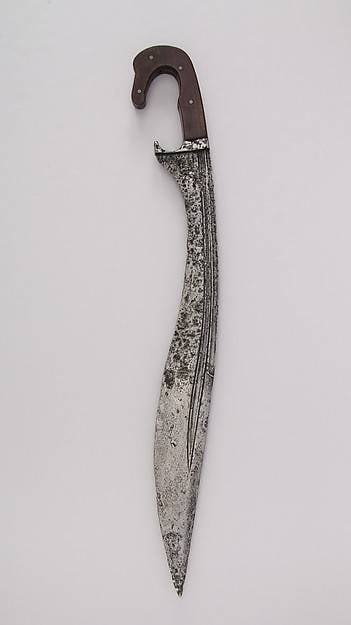
Falcata 43,2nd-473th centuries Pyrenees. Length XNUMX cm. Weight XNUMX g. Metropolitan Museum of Art, New York
The sword in the sling of the legionnaires was at first on the right, so that it was always at hand, while a dagger in a sheath hung on its side on the left. The centurions had swords on the left, since in their right hand the centurion held a cane made of vines, which served him for a variety of purposes, including for punishing the guilty.
Only in the 1rd century did the swords of the Romans finally “move” to the left side, and so all European warriors remained there. Many English-speaking historians are surprised to note that the swords of the knights of the second half of the XNUMXth century bear an amazing resemblance to the long swords of the Roman cavalrymen - this is the same length, and the rhombic section of the blade, and even the size of the hilt [XNUMX].
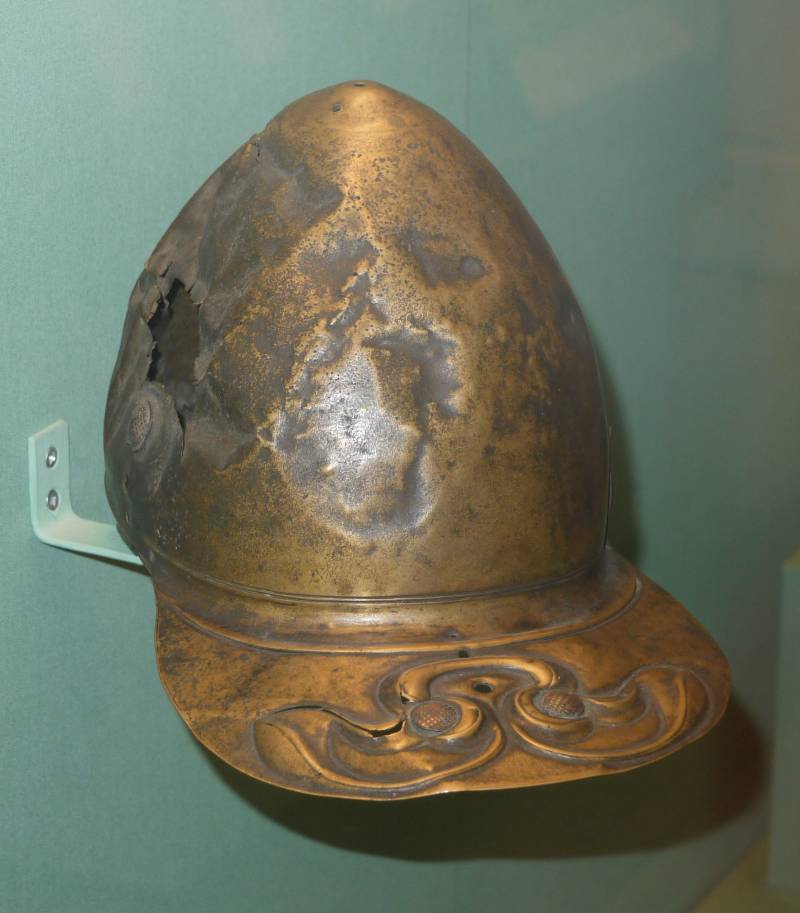
Celtic helmet of the XNUMXst century. n. e. Decorated with chasing in the La Tène style. British museum
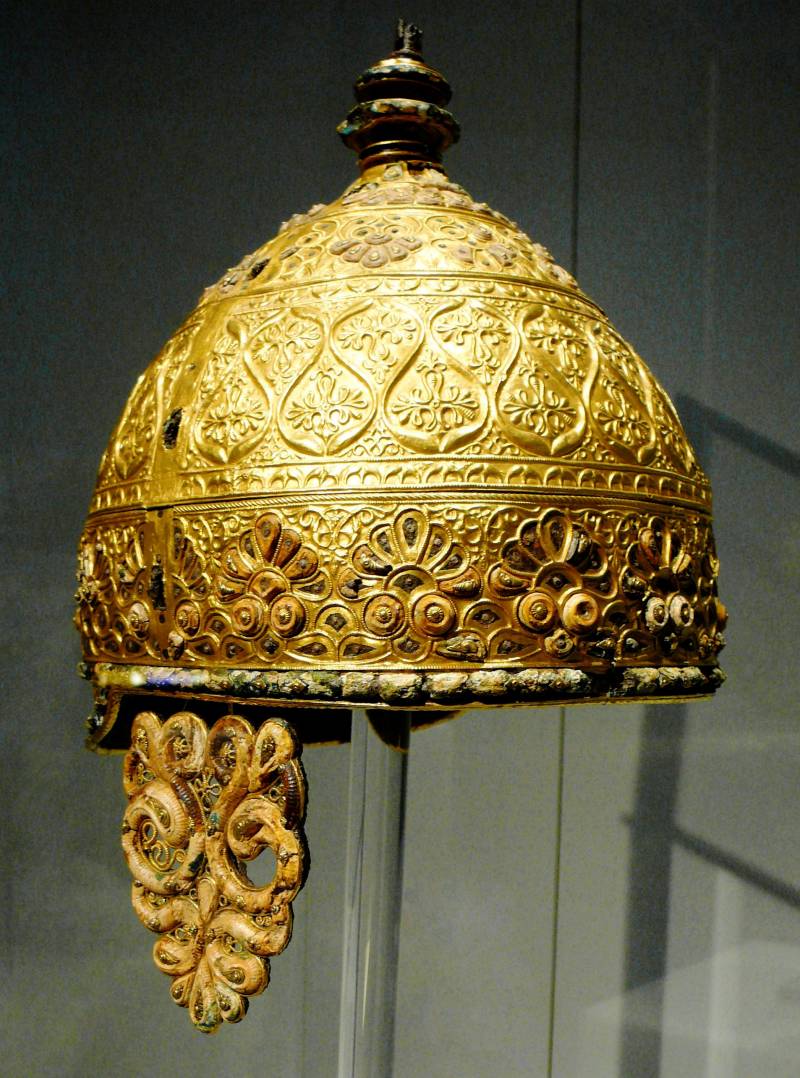
Celtic ceremonial helmet 350 BC e. from a cave in Agris, Western France. Museum of Angouleme, France
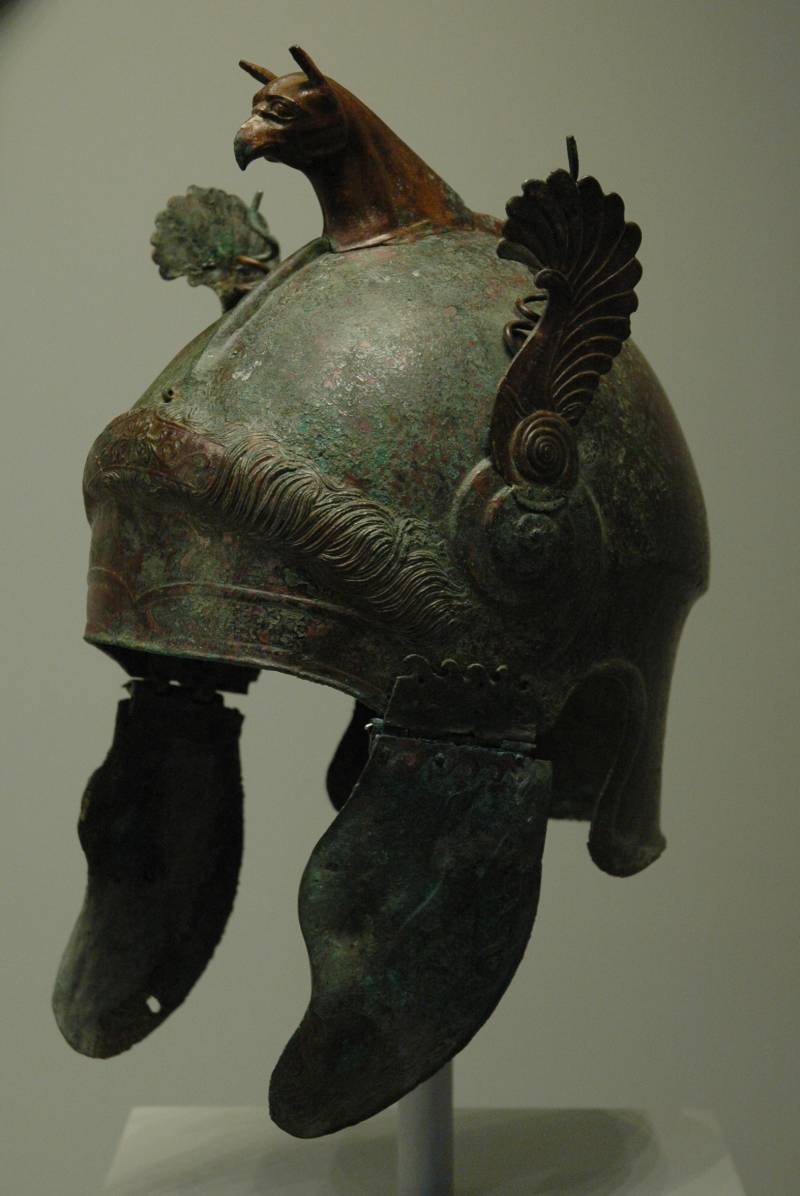
Ceremonial Greek helmet 350–300 AD BC e. from Southern Italy. Villa Getty
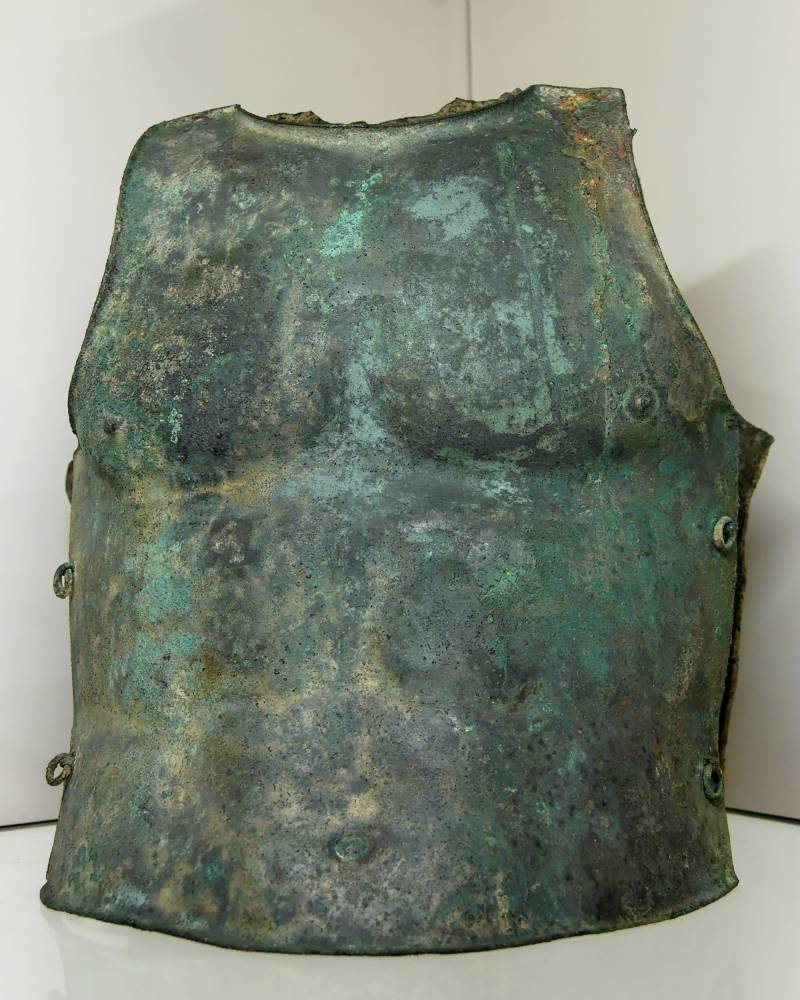
Anatomical bronze armor from southern Italy. About 350–300 BC BC e. British museum
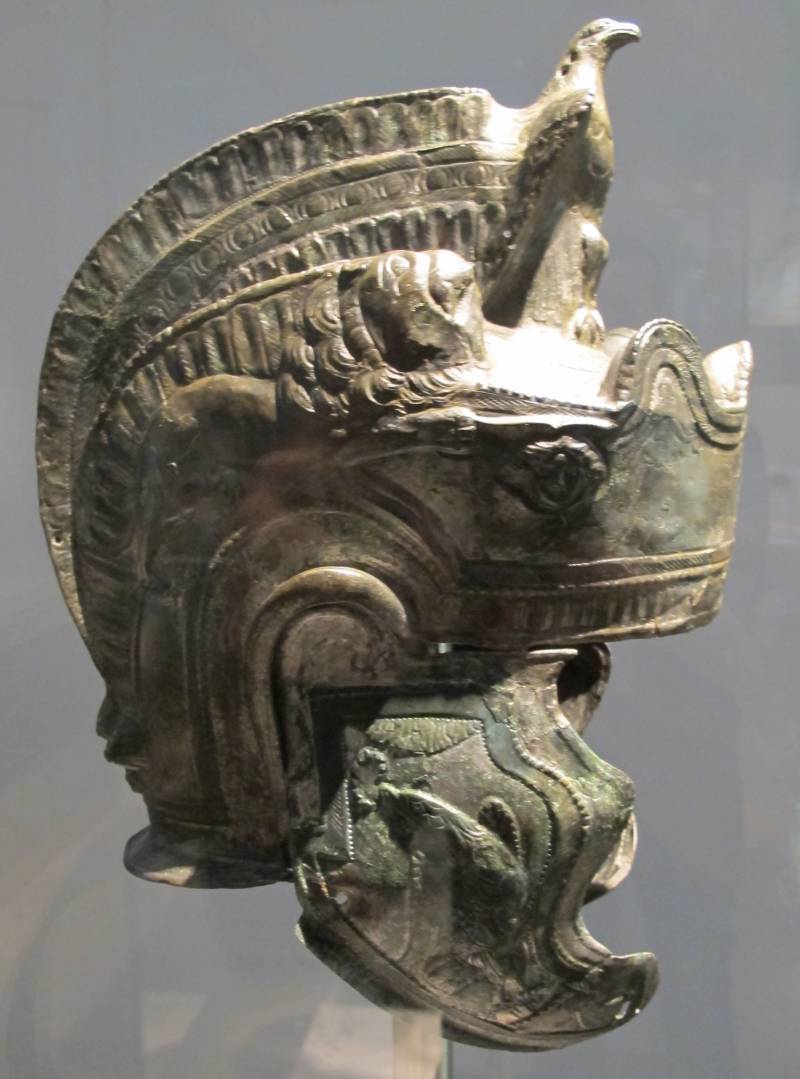
Lush and frankly tasteless helmet of a Roman horseman made of tinned bronze. Tylenhofen. About 174 AD e. State Collection of Prehistoric Antiquities, Munich
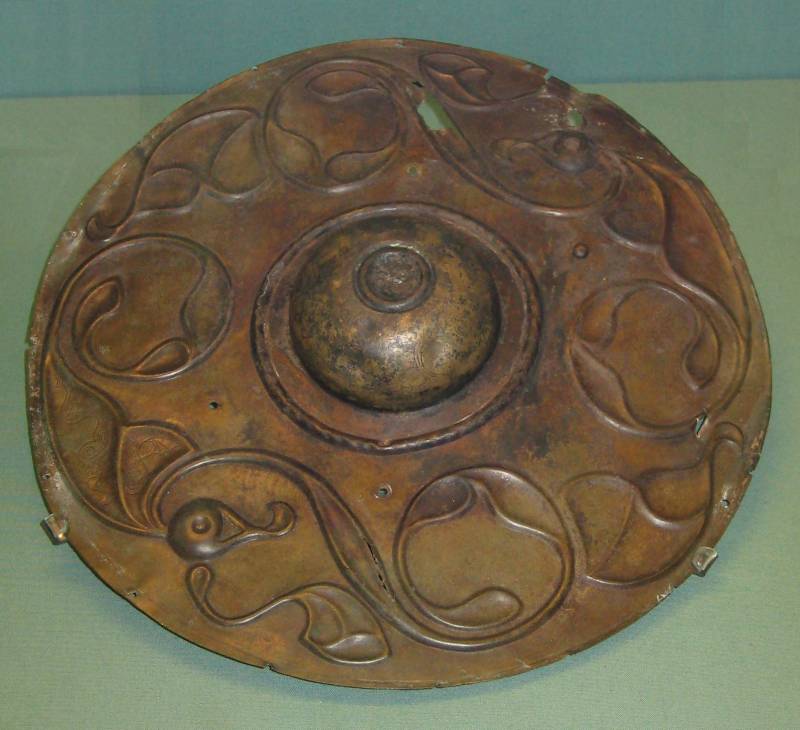
A bronze shield known as the "Shield of Wandsworth". Diameter 33 cm. British Museum
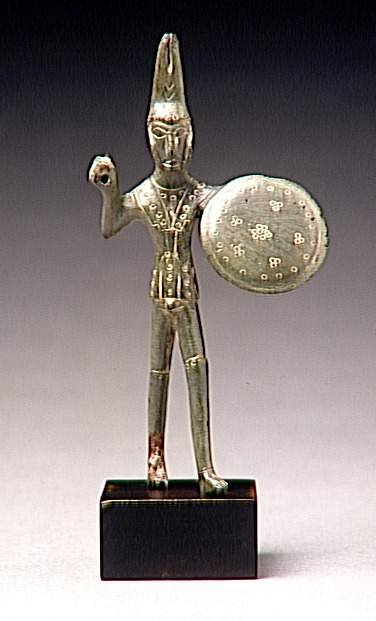
Etruscan warrior with a shield. Viterbo. Around 520–470 AD BC e. Louvre, Paris
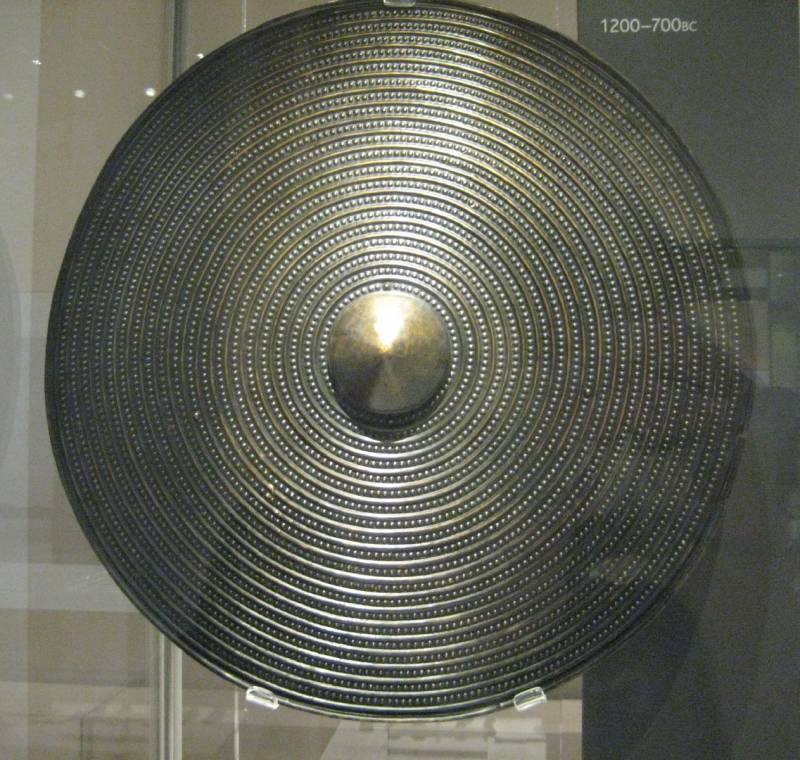
Bronze shield. Around 1200–700 AD BC e. British museum
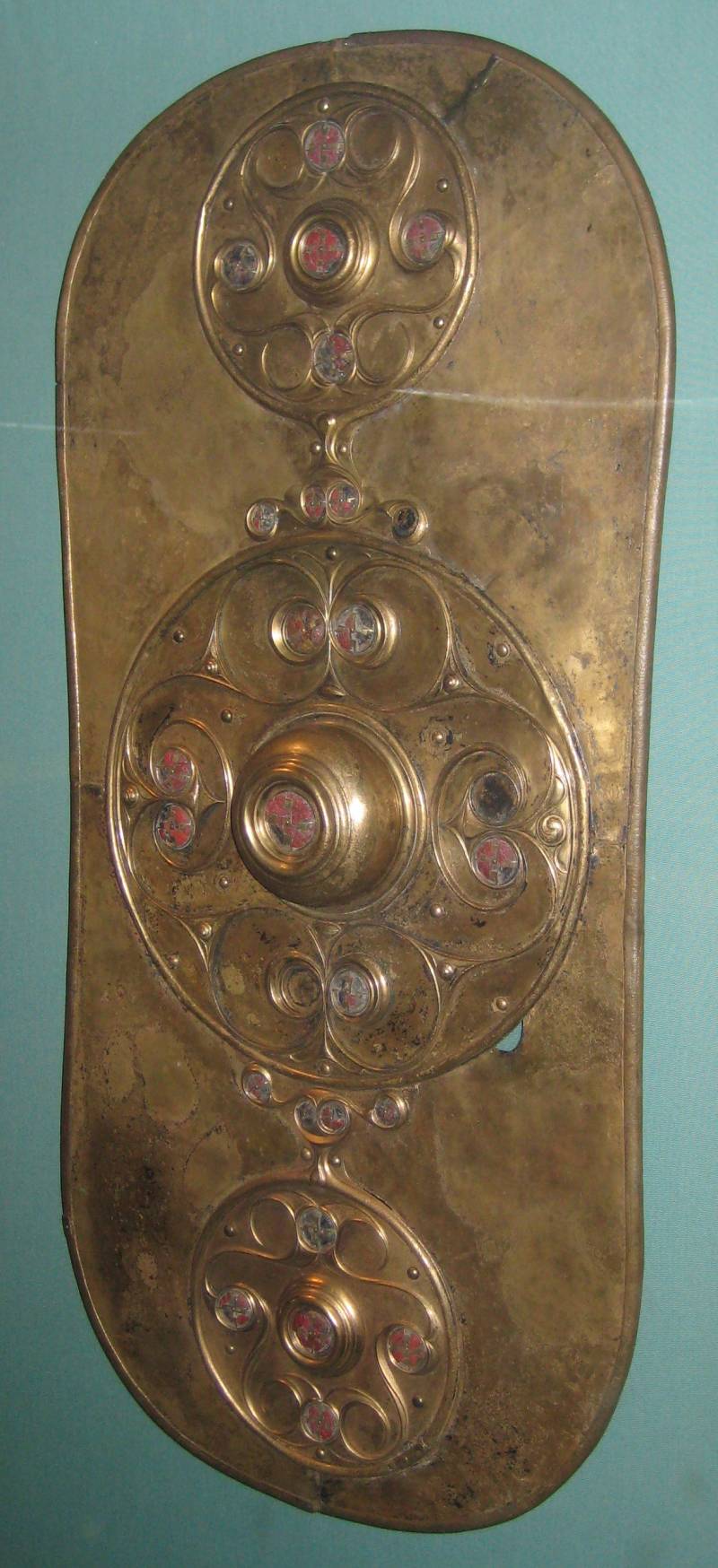
The famous Celtic bronze shield, also known as the "Battersea Shield". Length: 77,7 cm Width: 34,1-35,7 cm British Museum
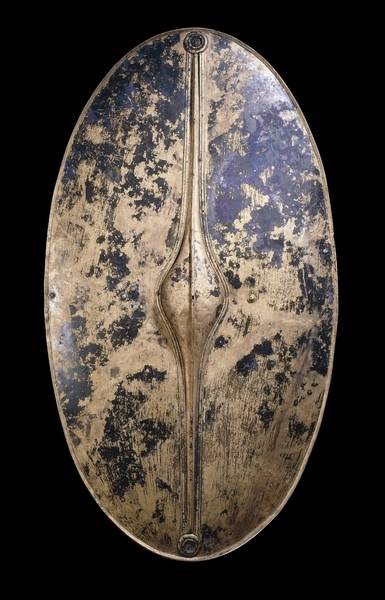
Celtic bronze "Shield of Chertsey". British museum
Sources:
[1] Connolly P. Greece and Rome. The evolution of military art over 12 centuries, S. 260.
And also:
Sekunda N., Northwood S. Early Roman's armies. L., 1995.
Simkins M. The Roman army from Hadrian Constantine. L., 1998.
Wilcox P. Rome's enemies 2 – Gallic and British Celts. L., 1994.
Wilcox P. Rome's enemies 3 – Parthians and Sassanid Persians. L., 1993.
Trevino R. Rome's enemies 4 – Spanish armies. L., 1993.
Nicolle D. Rome's enemies 5 – The desert frontier. L., 1991.
Information